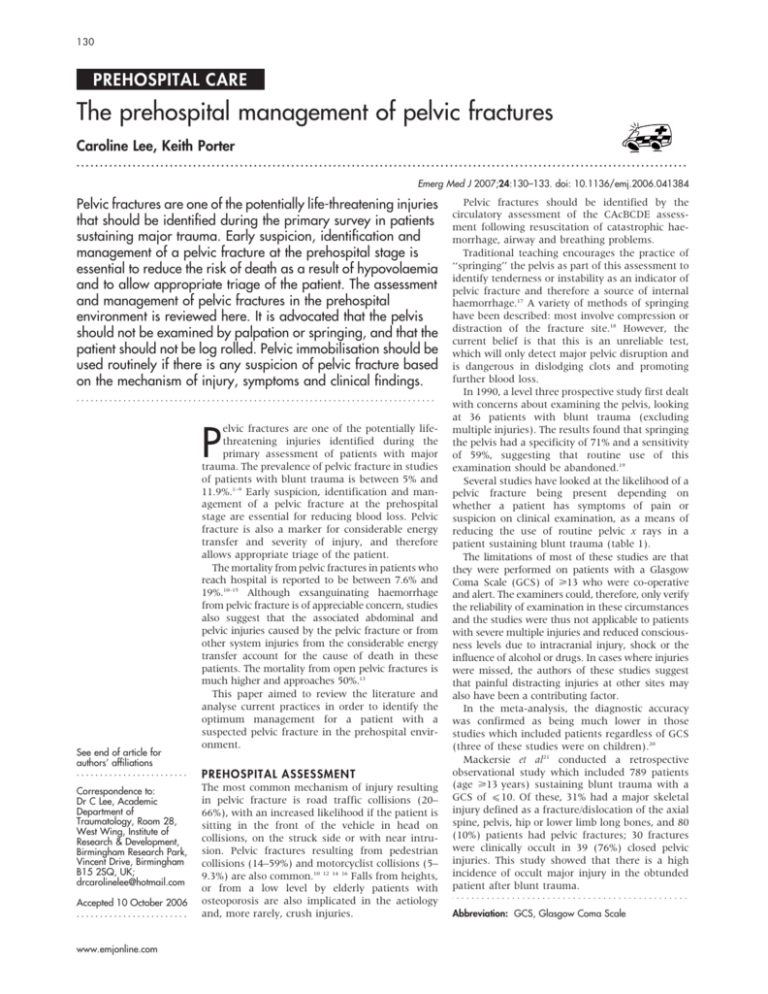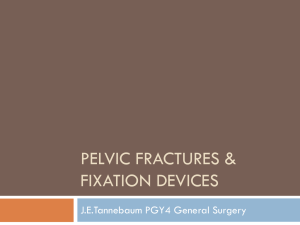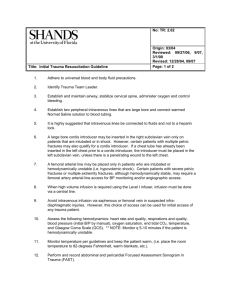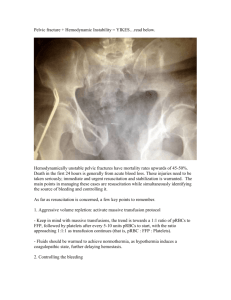The prehospital management of pelvic fractures
advertisement

130 PREHOSPITAL CARE The prehospital management of pelvic fractures Caroline Lee, Keith Porter ................................................................................................................................... Emerg Med J 2007;24:130–133. doi: 10.1136/emj.2006.041384 Pelvic fractures are one of the potentially life-threatening injuries that should be identified during the primary survey in patients sustaining major trauma. Early suspicion, identification and management of a pelvic fracture at the prehospital stage is essential to reduce the risk of death as a result of hypovolaemia and to allow appropriate triage of the patient. The assessment and management of pelvic fractures in the prehospital environment is reviewed here. It is advocated that the pelvis should not be examined by palpation or springing, and that the patient should not be log rolled. Pelvic immobilisation should be used routinely if there is any suspicion of pelvic fracture based on the mechanism of injury, symptoms and clinical findings. ............................................................................. P See end of article for authors’ affiliations ........................ Correspondence to: Dr C Lee, Academic Department of Traumatology, Room 28, West Wing, Institute of Research & Development, Birmingham Research Park, Vincent Drive, Birmingham B15 2SQ, UK; drcarolinelee@hotmail.com Accepted 10 October 2006 ........................ www.emjonline.com elvic fractures are one of the potentially lifethreatening injuries identified during the primary assessment of patients with major trauma. The prevalence of pelvic fracture in studies of patients with blunt trauma is between 5% and 11.9%.1–9 Early suspicion, identification and management of a pelvic fracture at the prehospital stage are essential for reducing blood loss. Pelvic fracture is also a marker for considerable energy transfer and severity of injury, and therefore allows appropriate triage of the patient. The mortality from pelvic fractures in patients who reach hospital is reported to be between 7.6% and 19%.10–15 Although exsanguinating haemorrhage from pelvic fracture is of appreciable concern, studies also suggest that the associated abdominal and pelvic injuries caused by the pelvic fracture or from other system injuries from the considerable energy transfer account for the cause of death in these patients. The mortality from open pelvic fractures is much higher and approaches 50%.13 This paper aimed to review the literature and analyse current practices in order to identify the optimum management for a patient with a suspected pelvic fracture in the prehospital environment. PREHOSPITAL ASSESSMENT The most common mechanism of injury resulting in pelvic fracture is road traffic collisions (20– 66%), with an increased likelihood if the patient is sitting in the front of the vehicle in head on collisions, on the struck side or with near intrusion. Pelvic fractures resulting from pedestrian collisions (14–59%) and motorcyclist collisions (5– 9.3%) are also common.10 12 14 16 Falls from heights, or from a low level by elderly patients with osteoporosis are also implicated in the aetiology and, more rarely, crush injuries. Pelvic fractures should be identified by the circulatory assessment of the CAcBCDE assessment following resuscitation of catastrophic haemorrhage, airway and breathing problems. Traditional teaching encourages the practice of ‘‘springing’’ the pelvis as part of this assessment to identify tenderness or instability as an indicator of pelvic fracture and therefore a source of internal haemorrhage.17 A variety of methods of springing have been described: most involve compression or distraction of the fracture site.18 However, the current belief is that this is an unreliable test, which will only detect major pelvic disruption and is dangerous in dislodging clots and promoting further blood loss. In 1990, a level three prospective study first dealt with concerns about examining the pelvis, looking at 36 patients with blunt trauma (excluding multiple injuries). The results found that springing the pelvis had a specificity of 71% and a sensitivity of 59%, suggesting that routine use of this examination should be abandoned.19 Several studies have looked at the likelihood of a pelvic fracture being present depending on whether a patient has symptoms of pain or suspicion on clinical examination, as a means of reducing the use of routine pelvic x rays in a patient sustaining blunt trauma (table 1). The limitations of most of these studies are that they were performed on patients with a Glasgow Coma Scale (GCS) of >13 who were co-operative and alert. The examiners could, therefore, only verify the reliability of examination in these circumstances and the studies were thus not applicable to patients with severe multiple injuries and reduced consciousness levels due to intracranial injury, shock or the influence of alcohol or drugs. In cases where injuries were missed, the authors of these studies suggest that painful distracting injuries at other sites may also have been a contributing factor. In the meta-analysis, the diagnostic accuracy was confirmed as being much lower in those studies which included patients regardless of GCS (three of these studies were on children).20 Mackersie et al21 conducted a retrospective observational study which included 789 patients (age >13 years) sustaining blunt trauma with a GCS of (10. Of these, 31% had a major skeletal injury defined as a fracture/dislocation of the axial spine, pelvis, hip or lower limb long bones, and 80 (10%) patients had pelvic fractures; 30 fractures were clinically occult in 39 (76%) closed pelvic injuries. This study showed that there is a high incidence of occult major injury in the obtunded patient after blunt trauma. Abbreviation: GCS, Glasgow Coma Scale Pelvic fractures 131 Table 1 Studies on reliability of history and examination in detecting pelvic fracture Prevalence of pelvic fracture n (%) Study type Author, date Patient group Outcomes Key results Salvino, 19921 810 patients with blunt trauma, age .12 years, GCS >13 39 (5%) Prospective observational study Pelvic fracture on x ray 125 patients with blunt trauma, age .16 years, GCS >13, SBP .100 mm Hg, no alcohol or drug intoxication, able to follow commands, no pain on palpation or movement 608 patients with blunt trauma, age .14 years, GCS >10, excluding haemodynamically unstable patients and spinal injuries 39 patients with blunt pelvic injury, age .10 years, GCS .13, excluded lower limb fractures and open pelvic fractures 82 adults, age .18 years, GCS .14, awake and alert 319 adults with blunt trauma had protocol-driven pelvic x rays None Prospective observational study Pelvic fracture on x ray 3/39 fractures not identified by history/examination. 28/771 suspected on history and/or examination but no fracture All patients had negative clinical examination 59 (9.7%) Prospective observational study Pelvic fracture on x ray 20 (51.2%) Prospective observational study Pelvic fracture on x ray 9 (10.9%) Prospective observational study Retrospective observational study 763 patients with blunt trauma, age .13 years, GCS .13, excluded spinal injury. Ethanol levels on all patients. Control group of 206 patients with no fractures 520 patients with blunt trauma. If GCS was (13 or signs/ symptoms of pelvic or back injury were noted, x ray of pelvis was requested 2176 patients with blunt trauma, GCS .14, measured ethanol level in all patients 55 (7.2%) Retrospective case– control study Pelvic fracture on x ray Positive clinical examination recorded in notes Record of physical examination. Ethanol level 45 (8.6%) Prospective observational study Pelvic fracture on x ray 97 (4.5%) Prospective observational study Pelvic fracture on x ray 5454 patients (adults or children) in 12 studies 549 (10.1%) Meta-analysis* Pelvic fracture on x ray Koury, 1993 2 Yugueros, 1995 Ham, 1996 3 4 Heath, 19975 Kaneriga, 1999 Tien, 20007 Duane, 20028 Gonzalez, 20029 Sauerland, 20 2004 6 38 (11.9%) 2/59 pelvic fractures not detected on examination (all stable, no further treatment required) 27/84 had positive examination but no fracture on x ray 2/20 pelvic fractures not identified on examination using active hip flexion as a marker for fracture 2/9 fractures not identified on examination 20/38 fractures were not suspected on examination 5/55 patients with pelvic fracture had no pain on history or examination (one open-book fracture). No difference in sensitivity/specificity of clinical evaluation if ethanol level .100 mg/ dl All 45 fractures identified on history or examination if protocol followed. 127/172 patients had positive examination but no fracture 7/97 fractures missed on clinical examination. Only one had ethanol level .100 mg/dl. 166/255 had positive examination but no fracture 49/441 fractures missed on clinical examination. 3/49 clinically significant fractures (open book or requiring ORIF) but not all studies reported the nature of injury therefore may be .3/49 GCS, Glasgow Coma Scale; ORIF, open reduction and internal fixation; SBP, systolic blood pressure. *Including some of the journals referenced in this paper. Civil et al22 prospectively assessed 265 patients who sustained blunt trauma and who received pelvic x rays. The patients were classified into four groups based on whether they were alert/ awake/orientated/asymptomatic or symptomatic or impaired (GCS .8 but ,15) or unconscious (GCS (8). There were 26 (9.8%) pelvic fractures identified on plain x rays. Of those patients, no fractures were identified in the 110 alert patients, 8 fractures were found in the 23 (34.7%) symptomatic patients, 11 fractures were found in 96 patients with impairment (11.4%) and 7 fractures were found in 36 unconscious patients (19.4%). This study again validated clinical assessment in the alert patient and identified the risk of significant injury being missed in the obtunded group. In the Gonzalez et al’s9 study of patients with GCS 14 or 15, the most common positive finding in patients with pelvic fractures was of the patient complaining of pelvic pain (67% of 97 patients) whereas only 32% had pain on iliac compression and 37% had pain on palpation of the pubic symphysis. In summary, the prehospital practitioner first needs to assess the mechanism of injury to be able to predict a potential pelvic fracture. Alerting features suggestive of significant pelvic injury during examination include deformity, bruising or swelling over the bony prominences, pubis, perineum or scrotum. Leg-length discrepancy or rotational deformity of a lower limb (without fracture in that extremity) may be evident. Wounds over the pelvis or bleeding from the patient’s rectum, vagina or urethra may indicate an open pelvic fracture. Neurological abnormalities may also rarely be present in the lower limbs after a pelvic fracture. Discrete rectal or vaginal bleeding or a high-riding prostate will not be detected in the prehospital environment. In the alert, orientated, cooperative patient with no distracting injury, it will be possible for the prehospital practitioner to ask the patient about the presence of pain in the pelvic area, including the lower back (assessing the sacroiliac joint), groin and hips. Any positive reply should call for routine immobilisation of the pelvis. In the absence of any symptoms or signs of pelvic fracture as described above, discharge from scene is an option, provided there are no other injuries requiring transfer to a hospital. In the case of the unresponsive trauma patient, the pelvis should not be palpated for tenderness or instability. A pelvic www.emjonline.com 132 fracture should be assumed to be present and routinely immobilised as described below. HAEMORRHAGE CONTROL Traditional teaching advises that the emergency management of pelvic fractures includes internal rotation of the lower limbs to reduce the pelvic volume and circumferential wrapping of a sheet around the pelvis as a sling.17 Reduction and stabilisation of pelvic ring injuries should occur as soon as possible after injury,23 while clotting mechanisms are still intact, before irretrievable haemorrhage has occurred and before the patient’s movement and transport. Haemorrhage after a pelvic ring fracture commonly occurs from injury to the sacral venous plexus, branches of the hypogastric artery, the fracture surfaces and surrounding soft tissue injury. With circumferential pressure and stabilisation, bony bleeding is reduced by apposition of the fracture site, and the reduced movement of bone ends prevents disruption of a formed clot. The increase in volume of the true pelvis, which results from a fracture with massive diastasis, is fairly small,24 and therefore it is unlikely that the mechanism of reducing pelvic volume by external reduction will create a tamponade effect.25 Haemodynamic stability may be achieved after reduction and stabilisation of a pelvic ring fracture in the absence of a major arterial injury. Hypotensive shock on admission to hospital correlates with mortality.12 26 Successful realignment of open-book fractures with basic methods of applying a circumferential bedsheet were described in case reports of one patient in 199727 and of two patients in 2002.28 The authors acknowledged that the use of bed sheets was an inexact and irreproducible method. There is no control over how tightly the sheet should be applied, they are sometimes a challenge to secure with sufficient reduction force and it is not certain whether overcompression of fractures could occur from using this method. Pneumatic anti-shock garments also known as military or medical anti-shock trousers or G suits, have also been a popular choice for splintage of pelvic fractures.29 However, their use restricts critical access to the abdominal and pelvic area, they are difficult to apply and do not allow for controlled pelvic reduction. Prospective randomised studies have not shown any definite benefits in reducing mortality or hospital/intensive care length of stay, and there are potential complications from their use related to compression of the lower extremities and abdomen.30 31 External fixators are clearly not practical for use in the prehospital environment, are often applied incorrectly and are associated with a high rate of complications (up to 47%).32 Meighan et al33 interviewed 31 major accident units in Scotland to determine their ability to stabilise a pelvic fracture if a patient were to present to their department. Only 8 of 31 (25.8%) departments would have been able to potentially stabilise a pelvis within 1 h. Eight units had no appropriate emergency treatment devices available at all. Therefore, a pelvic splint that can be applied in a prehospital setting is a rapid, safe alternative for haemorrhage control, and equally has benefits as a simple method for use by the junior medical and nursing staff in an emergency department setting. An improvised use of splints, which has been suggested, is to use a Kendrick extrication device, slid under the patient upside down (with the head support towards the feet) and the straps secured around the waist and legs. This also does not use a specific amount of tension. Vermeulen et al34 first described the prehospital use of an external pelvic compression belt (Geneva belt) in a series of 19 patients in 1999. Their device was applied by paramedics at the accident scene within 3 seconds on clinical suspicion of www.emjonline.com Lee, Porter unstable pelvic fractures. Thirteen patients were found to have a pelvic ring lesion. Of note were two patients who showed no abnormalities on an initial pelvic x ray despite fractures being present, thus proving adequate reduction by this method. Since then, a variety of commercial material compression splints have been manufactured. Examples include the Stuart splint, the London splint, the Dallas pelvic binder and the Trauma Pelvic Orthotic Device (Cybertech Medical TM, California, USA). They are generally applied at the level of greater trochanters/ symphysis pubis directly on to the patient’s skin. One study determined the mean (SD) force required to reduce unstable open book pelvic fractures (180 (50) N) on cadaveric models. This led to the development of new commercial splints (SAMsling, SAM Medical Products TM, Oregon, USA), which use controlled and consistent stabilisation with an autostop buckle to reduce the risk of overcompression in case of internal rotation injuries of the pelvic ring.35 36Krieg et al37 used this device to temporarily stabilise pelvic fractures in 13 patients (6 unstable fractures) and reported effective reduction based on radiological findings, with an absence of complications and anecdotal evidence of pain relief in several alert patients. A review of the literature found only one case report of complications (bilateral peroneal nerve palsy) after the application of an ‘‘external non-invasive compression device’’.38 In this example, sheets were wrapped around the patient at the level of the pelvis, knees and ankles. Therefore, direct compression over the fibula heads was the cause, which is not applicable to the use of a pelvic compression splint. Effective anatomical reduction described by Vermeulen et al 34 was also described in two case reports in 2005. Both patients had pelvic fractures detected by a plain x ray as part of the trauma series. An external compression splint (Stuart pelvic harness) was applied, after which the patient underwent computed tomography scanning that showed almost complete anatomical reduction.39 This highlights the need for prehospital practitioners to ensure that the receiving emergency department is aware that the pelvic splint should remain in situ throughout resuscitation, should not be removed prematurely and that imaging may appear normal despite the presence of relevant fractures. If initial plain x rays show no evidence of fracture but clinical suspicion is high, it would be advisable to slightly loosen the splint and repeat the plain x ray or to proceed with computed tomography imaging. FLUID RESUSCITATION Fluid resuscitation of the patient with pelvic trauma is consistent with the Faculty of Prehospital Care consensus guidelines promoting hypotensive resuscitation in the presence of non-compressible haemorrhage. After the arrest of external haemorrhage and splintage of pelvic and femoral fractures, fluid resuscitation should be considered based on the presence or absence of a radial pulse. Cannulation should take place en route to avoid unnecessary delays in the transport to definitive care and only two attempts should be made (the exception to this being where intravenous access is necessary in a stable patient for analgesia to facilitate patient handling). Boluses of 250 ml normal saline should be titrated until restoration of the radial pulse.40 These principles are supported by the National Institute for Health and Clinical Excellence in the guideline Prehospital initiation of fluid replacement therapy in trauma.41 TRANSPORT AND HANDOVER The patient should be provided with analgesia if awake, haemodynamically stable and complaining of pain, before movement. Intravenous morphine or ketamine are appropriate choices titrated to effect. Cannulation should not delay transport to the hospital in the critically injured or unstable patient. Pelvic fractures Log rolling the patient on to a spinal board should be avoided for the same reasons as compression and distraction of the pelvis in clinical examination. Both authors have anecdotal evidence of patients with pelvic fractures becoming haemodynamically unstable after routine log roll for back examination in emergency departments. Following application of pelvic splint, the patient should have a scoop stretcher placed under the body, with a maximum log roll of approximately 15˚ to facilitate positioning. The scoop can then be lifted directly on to an ambulance trolley cot, a spinal board or a vacuum mattress for transportation. On arrival at the emergency department, the patient can be moved on to the hospital trolley using a scoop stretcher which can be split and removed to avoid pressure complications. Prehospital practitioners should select the most appropriate emergency department facility with trauma capabilities for their patient. The handover to hospital staff should include information that the pelvic splint should not be removed until an assessment has been made by senior medical staff in the emergency department. This clinician should recognise the risk of removing a properly applied splint in the presence of a suspected unstable pelvic injury. In these cases, the pelvic splint should not be removed until radiology excludes a fracture (beware of false reassurances from anatomical reduction by splint) or the patient is in a theatre where direct haemorrhage control can be undertaken. CONCLUSIONS Prehospital management of a suspected pelvic fracture should adhere to the following principles: N N N N N N N N Read the mechanism of injury. Ask the alert patient about the presence of pain in the pelvic, back or groin regions and routinely immobilise the pelvis if there is any positive reply. Examination is unreliable (especially if reduced GCS, or distracting injuries) and the pelvis should not be palpated, to avoid further internal haemorrhage. If there is any suspicion of fracture, immobilise the pelvis using an external compression splint (commercial or modified eg, sheet). Do not fully log roll the patient. Use a scoop stretcher to facilitate the patient’s movement on to a spinal board or vacuum mattress for transport. In the emergency department, this process should be reversed. Fluid resuscitation to maintain a radial pulse only. Do not remove a pelvic splint in the presence of a suspected unstable pelvic injury until it is radiologically confirmed that there is no fracture or the patient is in a theatre. ....................... Authors’ affiliations Caroline Lee, Keith Porter, Academic Department of Traumatology, West Midlands, UK Competing interests: None. REFERENCES 1 Salvino CK, Esposito TJ, Smith D, et al. Routine pelvic x-ray studies in awake blunt trauma patients: a sensible policy? J Trauma 1992;33:413–16. 2 Koury HI, Peschiera JL, Welling RE. Selective use of pelvic roentgenograms in blunt trauma patients. J Trauma 1993;34:236–7. 3 Yugueros P, Sarmiento JM, Garcia AF, et al. Unnecessary use of pelvic x-ray in blunt trauma. J Trauma 1995;39:722–5. 4 Ham SJ, Van Walsum AD, Vierhout PA. Predictive value of the hip flexion test for fractures of the pelvis. Injury 1996;27:543–4. 133 5 Heath FR, Blum F, Rockwell S. Physical examination as a screening test for pelvic fractures in blunt trauma patients. W Vi Med J 1997;93:267–9. 6 Kaneriga PP, Schweitzer ME, Spettell C, et al. The cost-effectiveness of routine pelvic radiography in the evaluation of blunt trauma patients. Skeletal Radiol 1999;28:271–3. 7 Tien IY, Dufel SE. Does ethanol affect the reliability of pelvic bone examination in blunt trauma? Ann Emerg Med 2000;36:451–5. 8 Duane TM, Tan BB, Golay D, et al. Blunt trauma and the role of routine pelvic radiographs: a prospective analysis. J Trauma 2002;53:463–8. 9 Gonzalez RP, Fried PQ, Bukhalo M. The utility of clinical examination in screening for pelvic fractures in blunt trauma. J Am Coll Surg 2002;195:740. 10 Poole GV, Ward EF, Muakkassa FF, et al. Pelvic fracture from major blunt trauma. Outcome is determined by associated injuries. Ann Surg 1991;213:538–9. 11 Poole GV, Ward EF. Causes of mortality in patients with pelvic fractures. Orthopaedics 1994;17:691–6. 12 Gustavo J, Coimbra R, Rasslan S, et al. The role of associated fractures on outcome of blunt trauma patients sustaining pelvic fractures. Injury 2000;31:677–82. 13 Rothenberger DA, Fischer RP, Strate RG, et al. The mortality associated with pelvic fractures. Surgery 1978;84:356–61. 14 Dalal SA, Burgess AR, Siegal JH, et al. Pelvic fracture in multiple trauma: classification by mechanism is key to pattern of organ injury, resuscitative requirements, and outcome. J Trauma 1989;29:981–1000. 15 Chong KH, DeCoster T, Osler T, et al. Pelvic fractures and mortality. Iowa Orthop J 1997;17:110–14. 16 Moffatt CA, Mitter EL, Martinez R. Pelvic fractures crash vehicle indicators. Accid Anal Prev 1990;22:561–9. 17 American College of Surgeons. Advanced trauma life support, 7th edn. Chicago, IL: American College of Surgeons, 2004. 18 MacLeod M. Powell JN. Evaluation of pelvic fractures. Clinical and radiologic. Orthop Clin North Am 1997;28:299–319. 19 Grant PT. The diagnosis of pelvic fractures by ‘springing’. Arch Emerg Med 1990;7:178–82. 20 Sauerland S, Bouillon B, Rixen D, et al. The reliability of clinical examination in detecting pelvic fractures in blunt trauma patients: a meta-analysis. Arch Orthop Trauma Surg 2004;124:123–8. 21 Mackersie RC, Shackford SR, Garfin SR, et al. Major skeletal injuries in the obtunded trauma patient: a case for routine radiological survey. J Trauma 1988;28:1450–4. 22 Civil ID, Ross SE, Botehlo G, et al. Routine pelvic radiography in severe blunt trauma: is it necessary? Ann Emerg Med 1988;17:488–90. 23 Waikakul S, Harnroongroj T, Vanadurongwan V. Immediate stabilization of unstable pelvic fractures versus delayed stabilisation. J Med Assoc Thai 1999;82:637–42. 24 Moss MC, Bircher MD. Volume changes within the true pelvis during disruption of the pelvic ring – where does the haemorrhage go? Injury 1996;27(Suppl 1):A21–3. 25 Grimm MR, Vrahas MS, Thomas KA. Pressure-volume characteristics of the intact and disrupted pelvic retroperitoneum. J Trauma 1998;44:454–9. 26 Starr AJ, Griffen MA. Pelvic ring disruptions: mechanisms, fracture pattern, morbidity and mortality. An analysis of 325 patients. OTA Annual Meeting, Texas, USA, 2000. 27 Routt MLC, Simonian PT, Swionthkowski MF. Stabilisation of pelvic ring disruptions. Orthop Clin North Am 1997;28:369–88. 28 Simpson T, Krieg JC, Heuer F, et al. Stabilization of pelvic ring disruptions with a circumferential sheet. J Trauma 2002;52:158–61. 29 Salamone JP, Ustin JS, MsSwain NE, et al. Opinions of trauma practitioners regarding prehospital interventions for critically injured patients. J Trauma 2005;58:509–15. 30 Mattox KL, Bickell W, Pepe PE, et al. Prospective MAST study in 911 patients. J Trauma 1989;29:1104–12. 31 Chang FC, Harrison PB, Beech RR, et al. PASG: does it help in the management of traumatic shock? J Trauma 1995;39:453–6. 32 Palmer S, Fairbank AC, Bircher M. Surgical complications and implications of external fixation of pelvic fractures. Injury 1997;28:649–53. 33 Meighan A, Gregori A, Kelly M, et al. Pelvic fractures: the golden hour. Injury 1998;29:211–13. 34 Vermeulen B, Peter R, Hoffmeyer P, et al. Prehospital stabilization of pelvic dislocations: a new strap belt to provide temporary hemodynamic stabilization. Swiss Surg 1999;5:43–6. 35 Bottlang M, Krieg JC, Mohr M, et al. Emergent management of pelvic ring fractures with use of circumferential compression. J Bone Joint Surg 2002;84A(Suppl 2):43–7. 36 Bottlang M, Simpson T, Sigg J, et al. Noninvasive reduction of open-book pelvic fractures by circumferential compression. J Orthop Trauma 2002;16:367–73. 37 Kreig JC, Mohr M, Ellis TJ, et al. Emergent stabilization of pelvic ring injuries by controlled circumferential compression: a clinical trial. J Trauma 2005;59:659–64. 38 Shank JR, Morgan SJ, Smith WR, et al. Bilateral peroneal nerve palsy following emergency stabilization of a pelvic ring injury. J Orthop Trauma 2003;17:467. 39 Quereshi A, McGee A, Cooper JP, et al. Reduction of the posterior pelvic ring by non-invasive stabilisation: a report of two cases. Emerg Med J 2005;22:885–6. 40 Revell M, Porter K, Greaves I. Fluid Resuscitation in prehospital trauma care: a consensus view. Emerg Med J 2002;19:494–8. 41 National Institute for Health and Clinical Excellence (NICE). Pre-hospital initiation of fluid replacement therapy in trauma. London, UK: NICE, 2004. www.emjonline.com






